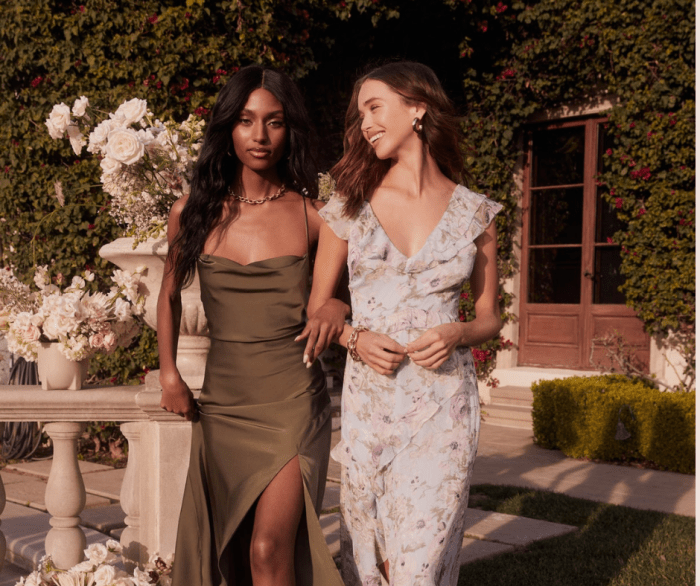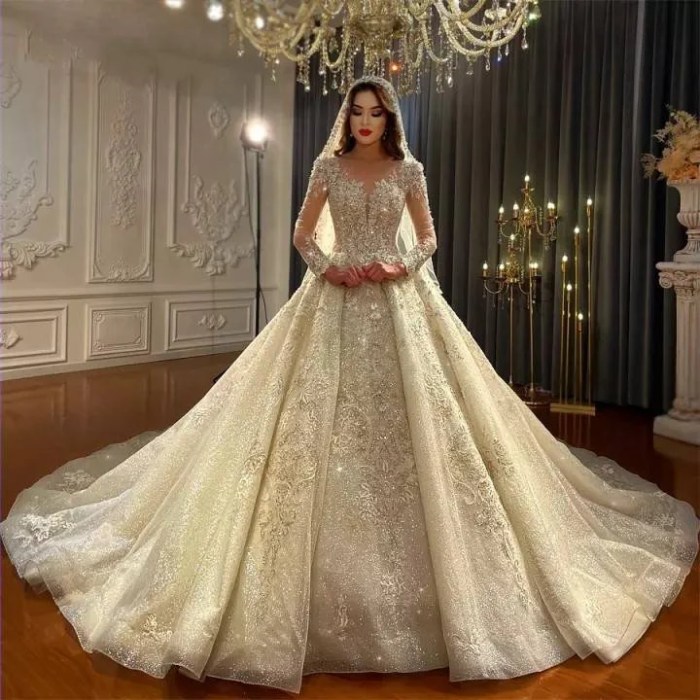Finding the Perfect Wedding Guest Dress
Nice dress for wedding – Attending a wedding requires careful consideration of your attire. Choosing the right dress involves understanding dress codes, considering the venue and season, and selecting a style that flatters your figure without overshadowing the bride. This guide provides a comprehensive overview of factors to consider when selecting a wedding guest dress.
Types of Wedding Guest Dresses
Various dress styles suit different wedding settings and personal preferences. The choice depends on the formality of the event, the season, and your body type.
| Dress Style | Formality | Suitable Fabric | Occasion Appropriateness |
|---|---|---|---|
| Maxi Dress | Formal to Semi-Formal | Silk, chiffon, lace | Evening weddings, formal garden weddings |
| Midi Dress | Semi-Formal to Casual | Cotton, linen, crepe | Afternoon weddings, cocktail receptions |
| Cocktail Dress | Semi-Formal to Casual | Silk, satin, lace | Cocktail receptions, less formal weddings |
| Tea-Length Dress | Semi-Formal | Lace, silk, crepe | Afternoon or evening weddings, garden parties |
Necklines also play a significant role. A V-neck elongates the torso, a sweetheart neckline accentuates the bust, and a halter neckline is flattering on various body types. Consider the overall aesthetic of the wedding when choosing a neckline.
Dress styles should also complement the wedding theme. Examples include:
- Beach Wedding: A flowing maxi dress in a light, breathable fabric like cotton or linen.
- Rustic Wedding: A midi dress in a floral print or lace, or a simple A-line dress in a natural fabric.
- Formal Wedding: A floor-length gown in silk or satin with elegant embellishments.
Dress Codes and Appropriateness
Understanding the dress code specified on the invitation is crucial. Black-tie requires a formal gown, semi-formal allows for cocktail dresses or elegant midi dresses, and casual suggests a more relaxed yet still polished outfit. It is essential to avoid upstaging the bride by choosing a dress that is elegant but not overly flashy or attention-grabbing.
Common dress code faux pas include wearing white (unless specifically requested), choosing a dress that is too revealing, or wearing attire that is significantly more formal or informal than the specified dress code. Always err on the side of being slightly underdressed rather than overdressed.
Fabric and Design Considerations

Source: collegefashion.net
Fabric selection impacts comfort and appearance. Silk and chiffon are luxurious choices for formal events, while cotton and linen are ideal for warmer weather. Lace adds a touch of elegance, while heavier fabrics like velvet are better suited for cooler months. Consider the season and climate when choosing your fabric.
Flattering silhouettes vary depending on body type. A-line dresses are universally flattering, while empire waist dresses emphasize the waistline. Consider your body shape and choose a style that accentuates your best features.
Dress embellishments can enhance the overall look. Some examples include:
- Beading: Adds sparkle and texture.
- Sequins: Provide a glamorous touch.
- Embroidery: Offers intricate detailing.
Color Palette and Accessories
Color choices should complement the wedding theme and avoid clashing with the bride’s attire. Pastel shades are generally appropriate for most weddings, while bolder colors might be suitable for more casual settings.
| Color | Wedding Theme | Appropriateness | Season |
|---|---|---|---|
| Navy Blue | Formal, Semi-Formal | Appropriate for most weddings | Year-round |
| Emerald Green | Formal | Elegant and sophisticated | Autumn, Winter |
| Blush Pink | Casual, Semi-Formal | Romantic and feminine | Spring, Summer |
| Coral | Beach, Summer | Bright and cheerful | Spring, Summer |
Shoes, jewelry, and handbags should complement the dress style. Heels are generally suitable for formal events, while flats or wedges might be more appropriate for casual weddings. Jewelry should be understated and elegant, and the handbag should be small and functional.
Finding the Perfect Dress, Nice dress for wedding
Finding the perfect dress involves a strategic approach. Start by considering the wedding’s formality and your personal style. Explore both online and in-store options, comparing prices and styles. When trying on dresses, pay attention to fit, comfort, and overall aesthetic.
Consider the following checklist when trying on dresses:
- Does the dress fit comfortably?
- Does the style flatter my body type?
- Is the color and fabric appropriate for the wedding?
- Does the dress feel right?
If alterations are needed, seek a professional tailor to ensure a perfect fit. Proper alterations can significantly enhance the overall look and feel of the dress.
Illustrative Examples

Source: etsystatic.com
Here are some detailed dress descriptions to illustrate suitable choices for different wedding settings:
A knee-length, A-line dress in navy blue chiffon with delicate lace detailing at the neckline and sleeves would be perfect for a summer garden wedding. The chiffon fabric flows beautifully, the navy blue is a sophisticated color choice, and the lace detailing adds a touch of elegance. The A-line cut is universally flattering.
A floor-length, emerald green silk gown with a modest V-neck and a subtle slit would be stunning for a formal evening wedding. The rich emerald green is a regal color, the silk fabric is luxurious, and the V-neck adds a touch of elegance without being too revealing. The subtle slit adds a touch of modernity.
A short, blush pink cocktail dress with a fitted bodice and a flared skirt, embellished with sequins, would be suitable for a more casual wedding reception. The blush pink is a cheerful and appropriate color, the fitted bodice accentuates the waistline, and the flared skirt adds a touch of fun. The sequins provide a touch of sparkle without being overly flashy.
Clarifying Questions: Nice Dress For Wedding
What if the wedding invitation doesn’t specify a dress code?
Finding a nice dress for a wedding can be a fun yet challenging process. The style greatly depends on the wedding’s theme; for a Western wedding, you’ll want to consider a range of options. To help you navigate the choices, check out this helpful guide on dresses to wear to a western wedding , which offers valuable insights into appropriate attire.
Ultimately, selecting a nice dress for a wedding involves careful consideration of the setting and your personal style.
If no dress code is provided, err on the side of semi-formal. A midi or cocktail dress in a sophisticated color is usually a safe bet.
Can I wear white to a wedding?
Generally, it’s best to avoid white, ivory, or cream, as these colors are traditionally reserved for the bride.
How far in advance should I start shopping for a wedding guest dress?
It’s advisable to start shopping at least a couple of months before the wedding to allow ample time for alterations or ordering if necessary.
What should I do if I can’t find a dress in my size?
Many tailors offer alterations services. Alternatively, consider shopping online for a wider selection of sizes.
